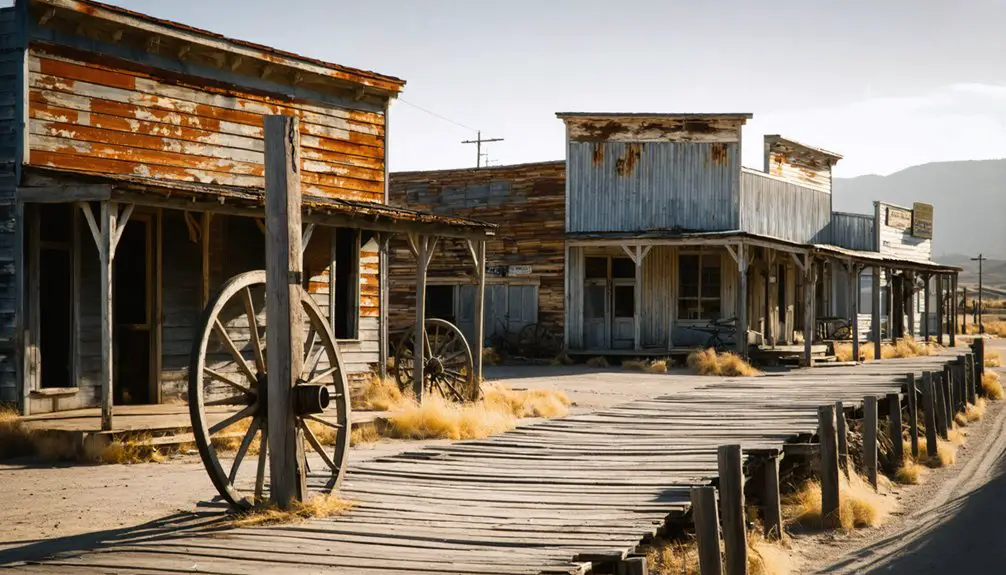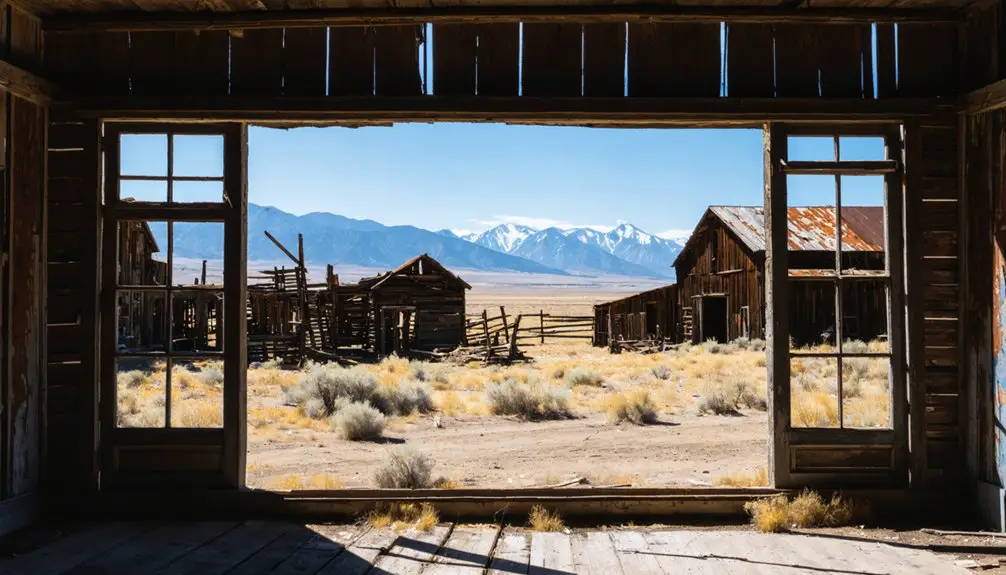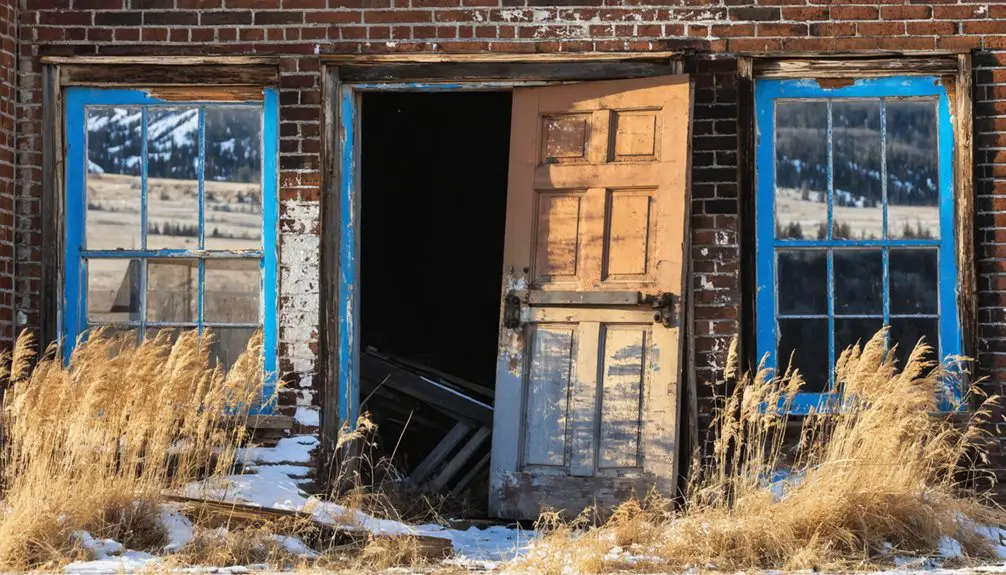You’ll find Nevada City, Montana nestled along Alder Gulch, where gold’s discovery in 1863 sparked a massive boom that drew over 10,000 residents. The town flourished with miners, merchants, and vigilante justice before declining into abandonment by 1876. Today, this carefully preserved ghost town features over 100 authentic frontier buildings, period-accurate demonstrations, and vintage artifacts. From restored miners’ cabins to working historic equipment, Nevada City’s Wild West legacy awaits your exploration.
Key Takeaways
- Nevada City began as a gold rush boomtown in 1863, reaching over 10,000 residents during its peak in 1864.
- The town declined rapidly after gold yields diminished, becoming virtually deserted by 1876.
- Dredging operations between 1898-1922 destroyed much of the original townsite’s remaining structures and landscape.
- The site was transformed into a living history museum in 1945, featuring over 100 authentic frontier buildings.
- Visitors can experience the Gold Rush era through historical reenactments, preserved buildings, and overnight stays in miners’ cabins.
The Gold Rush That Started It All
When gold was discovered in Alder Gulch in 1863, it sparked one of the Rocky Mountains’ most significant mining booms.
You’ll find that this discovery yielded the richest placer gold deposits ever found in the Rockies, with miners extracting an astounding $30 million worth of gold in just the first three seasons.
The economic impact of this gold rush transformed the region rapidly. Like many locations that share the name, Nevada City needed clear disambiguation links to distinguish it from other similarly named places.
Within months, a string of bustling settlements emerged along 14 miles of the gulch, forming what became known as the “Fourteen-mile City.”
The gold rush transformed Alder Gulch into a remarkable string of connected settlements, stretching fourteen miles through Montana’s rugged terrain.
Nevada City, established on June 6, 1863, became one of these key mining camps.
By 1876, the once-thriving settlement had become virtually deserted as the gold deposits were depleted.
The rush’s significance reached beyond local development, contributing directly to the creation of Montana Territory in 1864 and reshaping the American West’s territorial expansion.
Life in a Bustling Mining Town
In Nevada City’s heyday, you’d start your day at dawn working the placer mines, using sluice boxes and pans to extract gold from river gravels while merchants and craftsmen operated the town’s essential businesses.
Your mining tools would include picks, shovels, and gold pans, with some operations utilizing more sophisticated hydraulic equipment to process larger quantities of ore. The area proved incredibly lucrative, with thirty to forty million in gold extracted during the early mining period.
After dark, you could join fellow miners at the town’s saloons or the Nevada City Music Hall, where entertainment and socializing offered relief from the day’s physical labor. Today, visitors can explore over 100 buildings that have been carefully relocated from various Montana locations to preserve the town’s mining-era character.
Daily Activities and Work
During the peak of Nevada City’s gold rush in 1864, over 10,000 residents filled their days with mining, commerce, and essential support activities.
Your daily routines would have revolved around the town’s core industries, whether you were a placer miner sifting through creek beds, a merchant running one of three general stores, or a blacksmith repairing crucial mining equipment.
Work life extended beyond the mines, as you’d find locals operating the brewery, butcher shop, and livery stable.
You might’ve spent your evenings at one of two saloons or the Masonic Hall, where the community gathered.
If you weren’t mining, you might’ve worked the surrounding farmland, tended livestock, or run a boarding house to support the bustling mining workforce.
Mining Tools and Methods
Simple hand tools marked the early mining days of Nevada City, as prospectors relied on basic implements like pans and sluice boxes to separate precious gold from creek bed gravels.
You’d find miners wielding pickaxes, shovels, and hand drills to loosen the earth, using gravity to their advantage. Merchants often made more stable profits than the miners who sought their fortunes in the gulch. Charles Bovey helped preserve these mining tools and artifacts when he created open-air museums showcasing Nevada City’s history.
Mining innovations transformed the landscape in 1867 when hydraulic jets blasted hillsides with pressurized water, dramatically increasing gold extraction but scarring the terrain.
By 1899, massive dredges revolutionized operations, churning through 37 million cubic yards of earth. These mechanical giants created lasting environmental impacts, leaving behind tailings piles and dredge ponds where buildings once stood.
The evolution from manual tools to industrial machines reflected the area’s desperate hunt for gold, forever reshaping Nevada City’s natural environment and physical layout.
Entertainment After Dark
Life after sunset transformed Nevada City into a vibrant social hub where miners sought entertainment across three bustling saloons, the German-styled Road Agents’ Roost restaurant, and a local brewery.
You’d find the nighttime activities centered around storytelling, gambling, and live music, with miners unwinding after long days in the mines.
The town’s wooden boardwalks, dimly lit by gas lamps, connected these social hotspots where you could join the revelry.
The historic Criterion Hall store became a popular gathering spot for townspeople to share news and gossip during evening shopping trips.
Saloon culture dominated the evening scene, offering drinks and rowdy entertainment that earned the town its lively reputation.
The barber shops provided a place for miners to clean up and socialize before their evening entertainment.
If you weren’t at the saloons, you might catch an evening gathering at the Masonic Hall or join fellow workers sharing tales of mining fortunes under the moonlight, creating the authentic frontier experience that defined Nevada City’s after-dark charm.
The Rise of Vigilante Justice
In the lawless days of 1863, you’d find Nevada City’s miners taking justice into their own hands as over 100 deaths from road agent robberies pushed them to form citizen enforcement groups.
The Vigilance Committee executed at least twenty members of the Henry Plummer gang in early 1864.
You can trace the turning point to George Ives’ public trial in December 1863, where prosecutor William Fisk Sanders secured a guilty verdict that led to Ives’ hanging before 1,500 spectators.
The discovery of gold at Grasshopper Creek in 1862 had triggered the rush of miners and outlaws to the region.
Your visit to Boot Hill cemetery today reveals the graves of suspected road agents executed by the Vigilance Committee, who brought frontier justice through hangings marked with the mysterious numbers “3-7-77” between 1864 and 1867.
Miners Take Swift Action
While territorial law enforcement struggled to maintain order in eastern Idaho Territory during 1863-1864, miners and townspeople in Nevada City took justice into their own hands.
After the murder of Nicholas Tabalt by George Ives, you’d have witnessed the community’s breaking point. Vigilante motivations emerged from increasing “road agent” robberies and ineffective legal systems in the remote mining area.
You’ll find that miners quickly organized vigilance committees, complete with presidents, officers, and district captains operating in military-style units.
Their community justice approach was swift and severe – in just six weeks of 1864, they captured and hanged about 20 members of the Plummer gang.
Through public executions and summary trials, these miners established their own code of conduct, creating what became known as “pax vigilanticus” – order through fear.
Ives Trial Sets Precedent
Through a dramatic public spectacle that would reshape frontier justice, George Ives faced trial before a miners’ court on December 18, 1863, for the murder of Nicholas Tabalt.
You’ll find no formal courthouse in this makeshift tribunal – just 1,500 spectators gathered to witness a pivotal moment in Montana’s history. The three-day trial moved swiftly, with the jury deliberating less than an hour before voting 23-1 for conviction.
When crowds demanded Ives’ execution with shouts of “hang him,” you’d have witnessed the birth of vigilante justice in the American West.
Despite his final claims of innocence, Ives met the hangman’s noose on December 21. This watershed moment sparked the formation of the Montana Vigilantes, who’d soon take control of law enforcement throughout the territory’s mining camps.
Frontier Law Takes Shape
The Ives trial marked a watershed moment that ignited organized vigilante justice across Montana Territory.
As frontier ethics evolved, you’d find vigilance committees forming across mining towns, their members bound by strict oaths to maintain order through swift punishment.
These citizen-led groups shaped community dynamics in response to rampant crime and ineffective territorial law enforcement.
- Vigilantes coordinated actions between Bannack, Virginia City, and Nevada City to eliminate criminal gangs
- Committee members signed pledges committing to death as the only punishment for serious crimes
- Public executions on main streets served as stark warnings to potential lawbreakers
From Boom to Abandonment
After gold’s discovery in Alder Gulch during 1863, Nevada City emerged rapidly from Montana’s wilderness, transforming from empty land to a bustling settlement within months.
By 1869, you’d find a vibrant community of 100 residents supported by three general stores, two saloons, a brewery, and blacksmiths. Miners worked the streams while farmers and ranchers diversified the local economy.
Yet by 1876, Nevada City had become a ghost town. The once-promising settlement fell victim to declining gold yields, as miners abandoned their claims for richer prospects elsewhere.
The final blow came between 1898 and 1922, when massive dredging operations tore through the landscape, destroying much of what remained. The rapid economic decline marked a typical pattern of boom-and-bust cycles common to Western mining towns.
Preserving Montana’s Wild West Heritage
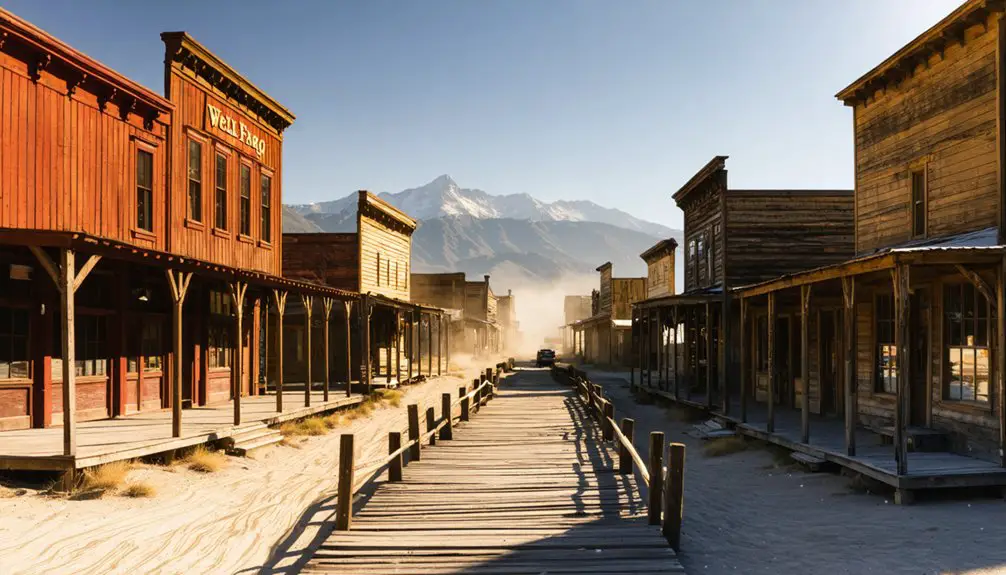
Modern preservation efforts safeguard Nevada City’s Wild West legacy through a coordinated network of state and local initiatives.
The Montana Heritage Commission’s Archaeological Program protects cultural preservation through carefully managed excavations, while the State Historic Preservation Office provides technical guidance for maintaining historic properties.
You’ll find community engagement flourishing through:
- Living History demonstrations of blacksmithing, mining, and frontier skills
- Volunteer archaeological digs revealing gold rush era artifacts
- Educational programs that bring the Wild West to life
The Revitalizing Montana’s Rural Heritage grant program finances restoration projects that maintain Nevada City’s authentic character.
These preservation initiatives guarantee you can experience a genuine piece of frontier history while supporting local stewardship of Montana’s cultural heritage for future generations.
Modern-Day Living History Museum
Since its transformation from abandoned mining settlement to vibrant museum in 1945, Nevada City has evolved into one of Montana’s premier living history destinations.
You’ll discover over 100 authentic frontier buildings, arranged precisely as they’d have stood during the Gold Rush era, housing one of the largest collections of Old West artifacts outside the Smithsonian.
From Memorial Day through Labor Day, you’ll experience interpretive programs featuring volunteers in period-accurate clothing demonstrating blacksmithing, card games, and other 1800s activities.
Step back in time as costumed interpreters bring frontier life to life through authentic demonstrations of 19th-century trades and pastimes.
Historical reenactments bring the town’s mining heritage to life, while the museum’s extensive collection of vintage music machines fills the air with period-appropriate melodies.
You can even stay overnight in preserved miners’ cabins, immersing yourself in the authentic atmosphere of Montana’s frontier past.
Planning Your Visit to Nevada City
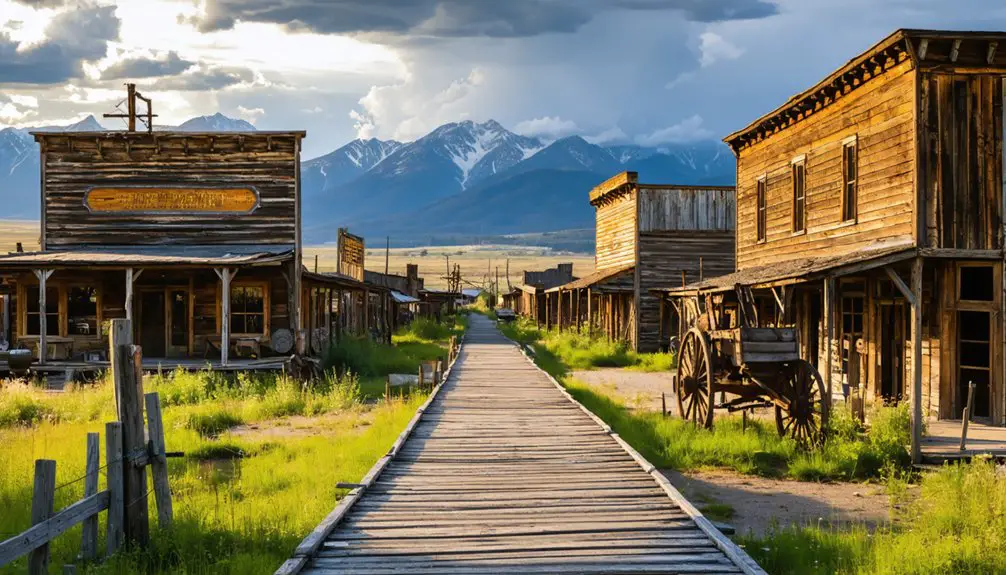
Planning a memorable visit to Nevada City starts with understanding its seasonal operations from Memorial Day through Labor Day. The historic site welcomes visitors daily from 10:00 AM to 6:00 PM, with admission ranging from $6-10 for adults, youth, and seniors.
Key attraction highlights and visitor tips include:
- Explore dozens of restored 1863-era buildings and one of the largest Old West artifact collections outside the Smithsonian.
- Experience gold panning at adjacent mining claims and watch living history demonstrations on weekends.
- Book an overnight stay in an authentic miner’s cabin for an immersive frontier experience.
Plan for a 2-3 hour visit wearing comfortable walking shoes suitable for wooden plank sidewalks. Bring cash or cards for admission and activities.
Consider combining your trip with nearby Virginia City for an extensive ghost town experience.
Frequently Asked Questions
Are There Any Documented Paranormal Activities or Ghost Sightings in Nevada City?
You’ll find documented ghostly encounters at Sedman House, including spectral sightings of a Victorian girl, unexplained footsteps, and mysterious bedding disturbances captured during film crews’ winter production of Ibsen’s play.
What Happened to the Original Gold Discovered in Alder Gulch?
You’ll find that gold rush treasure history shows Alder Gulch’s gold was largely spent locally, transported to financial centers, or used as currency before being melted down and entering the broader American economy.
Can Visitors Pan for Gold in Nevada City Today?
You can enjoy gold panning at the River of Gold site nearby, with equipment provided and “paydirt” available for purchase. Visitor experiences include unlimited panning with tourist passes during summer months.
Did Any Famous Wild West Personalities Ever Visit Nevada City?
Hard as a miner’s pickaxe, there’s no concrete evidence famous Wild West personalities visited Nevada City. While regional vigilantes gained local fame, legendary figures like Billy the Kid aren’t documented here.
What Native American Tribes Originally Inhabited the Nevada City Area?
You’ll find the Shoshone were first established in this Native American territory, with Bannocks and Sheepeaters arriving later. Their cultural heritage faced challenges during the 1863 gold rush era.
References
- https://www.legendsofamerica.com/mt-nevadacity/
- https://en.wikipedia.org/wiki/Nevada_City
- https://photoseek.com/2011/usa-montana-ghost-towns-history/
- https://www.rv.com/archive/virginia-city-and-nevada-city-living-ghost-towns/
- https://www.islands.com/1816452/nevada-city-wooden-boardwalks-steam-trains-bring-abandoned-montana-mining-town-life/
- https://southwestmt.com/communities/nevadacity/
- https://virginiacitymt.com/Preservation/Area-History
- https://montanacowboyfame.org/inductees/2008/10/the-nevada-city-hotel
- https://coloradosghosttowns.com/nevada city montana.html
- https://handstandsaroundtheworld.blog/2022/08/29/montana-road-trip-2022-v/
